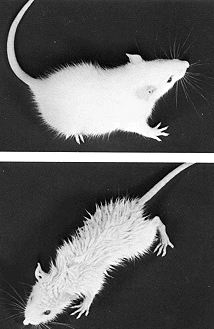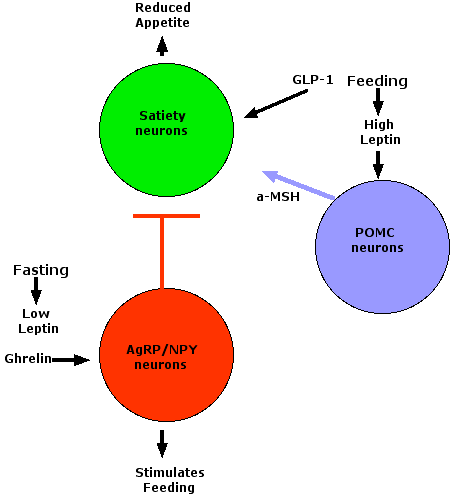- fewer double bonds and, of those that remain,
- converting them from a cis to a trans configuration.
| Link to discussion of the chemical nature of fats. |

| Index to this page |
| Link to discussion of the physiology of the gastrointestinal (GI) tract. |
Despite some uncertainties, the Food and Nutrition Board of the U. S. National Academy of Sciences publishes guidelines. One of the most useful of these is called recommended daily allowances or RDAs. These provide the basis for the nutrition labels on food.
| Link to table giving RDAs for men and women age 19–30. |
In some poor countries, too many children do not receive enough calories to grow properly. In order to maintain blood sugar levels, they attack their own protein. This condition of semi-starvation is known as marasmus.
Humans must include adequate amounts of 9 amino acids in their diet. These "essential" amino acids cannot be synthesized from other precursors. However, cysteine can partially meet the need for methionine (they both contain sulfur), and tyrosine can partially substitute for phenylalanine.
| Histidine |
| Isoleucine |
| Leucine |
| Lysine |
| Methionine (and/or cysteine) |
| Phenylalanine (and/or tyrosine) |
| Threonine |
| Tryptophan |
| Valine |
Two of the essential amino acids, lysine and tryptophan, are poorly represented in most plant proteins. Thus strict vegetarians should take special pains to ensure that their diet contains sufficient amounts of these two amino acids.
Birds, mammals, and some other animals are able to discriminate food that contains a nutrient, e.g., an essential amino acid, that they need from food that doesn't. If offered a food lacking that nutrient, they quickly stop eating it. How is this done? In rats, at least, it turns out that certain neurons in the brain detect the lack of an essential amino acid and signal the appetite centers of the brain to stop feeding on deficient food. The neurons detect the lack by the failure of their transfer RNAs (tRNAs) for that amino acid to acquire it. Rats whose tRNAs for threonine have been blocked from loading threonine cease feeding even if their food contains adequate concentrations of it. (See Hao et al, Science, 18 March 2005) |
Ingested fats provide the precursors from which we synthesize our own fat as well as cholesterol and various phospholipids. Fat provides our most concentrated form of energy. Its energy content (9 kcal/gram) is over twice as great as carbohydrates and proteins (4 kcal/gram).
Humans can synthesize fat from carbohydrates (as most of us know all too well!). However, three essential fatty acids cannot be synthesized this way and must be incorporated in the diet. These are
All are unsaturated; that is, have double bonds.| Link to discussion of the chemical nature of fats. |

At present, food labels in the U.S. list the total amount of fat in a serving of the product (5 g in the example shown here) with a breakdown of the amounts of saturated (1 g), polyunsaturated (0.5 g), and monounsaturated fat (1.5 g).
What about trans fats? There is a proposal to have them included, but at present they are not. However, if you add the amounts of saturated, polyunsaturated, and monounsaturated fat, and the total does not equal "Total Fat" , the discrepancy (2 g in this example) represents the amount of trans fat. Baked goods (like the one whose label is shown here) tend to have quite a bit of trans fat.
| But read all labels with a touch of skepticism — see below! |
| Link to further information of calcium in the diet. |
In developed countries like the U.S., iron deficiency is the most common mineral deficiency. It is particularly common among women because of the loss of blood during menstruation and the need for extra iron during pregnancy and breast feeding.
Marginal iron intake is so widespread that some nutritionists want to have iron added to common foods like bread and cereals, just as some vitamins now are. However, excess iron in the body also leads to problems, and this has made the proposal controversial.
Even iron supplement tablets pose risks: thousands of children in the U.S. are accidentally poisoned each year by swallowing too many iron tablets. In fact, iron is the most frequent cause of poisoning deaths among children in the U.S.
| Link to table giving recommendation for iron intake. |
| Link to table giving recommendation for iodine intake. |
Because iodine deficiency during pregnancy can lead to mental retardation of the infant, it is recommended that pregnant women receive 150–250 µg of iodine daily during both pregnancy and lactation. Hundreds of supplements — both prescription and nonprescription — are sold for this purpose. However, a study of 60 of them reported in the 2/26/09 issue of The New England Journal of Medicine found that only 9 of the 60 contained an amount of iodine within 5% of the amount claimed on the label. Others ranged from only 11% of the amount claimed to almost 3 times as much. Examples: one (prescription) preparation claiming a daily dose of 150 µg actually provided only 26 µg while another (nonprescription) preparation claiming 226 µg of iodine actually contained 610 µg!
The value of fluoride (in ionized form, F−) was first recognized as a preventive for dental caries (cavities). This makes sense because fluoride ions are incorporated along with calcium and phosphate ions in the crystalline structure of which both bones and teeth are constructed.

But it may have other functions. In order to grow properly, a rat must consume 0.5 parts per million (ppm) of fluoride ions in its diet. The rat in the bottom photo received the same diet as that in the top except that tin, vanadium, and fluorides were carefully excluded for 20 days. When tin and vanadium were then given to the deprived rat, it still did not grow normally. But adding 0.5 ppm of potassium fluoride (KF) to its diet restored normal growth and health. (Photos courtesy of Klaus Schwarz, VA Hospital, Long Beach, CA.)
Humans get most of their fluoride in drinking water. In regions where the natural amount is less than 1 ppm, many communities add enough fluoride to bring the concentration up to 1 ppm.
Perhaps because the range between optimum and excess is more narrow for fluoride than for most minerals in the diet, water fluoridation has been controversial. Leaving aside the philosophical and political questions raised by proponents and opponents of fluoridation, the safety and efficacy of this public health measure has been thoroughly established.
Zinc supplements are popular for their supposed antioxidant properties and to hasten the recovery from colds. Excessive intake of zinc causes a brief illness. Its most frequent cause is from ingested acidic food or drink that has been stored in galvanized (zinc-coated) containers.
| Link to table giving recommendations for vitamin intake. |
Breast milk provides less than 20% of the recommended daily dose for infants. Until the infant is old enough to eat foods fortified with vitamin D, many pediatricians recommend vitamin supplements for breast-fed babies.
| Link to table giving recommendations for vitamin intake. |
A complex web of signals controls appetite and the intake of food. These include both nerve signals and hormones — both of which signal centers in the brain — chiefly in the hypothalamus.
This table lists some of the hormonal signals that have been identified, their effect on appetite (and weight gain), and provides some links to pages where they are discussed.
Such complexity probably reflects the need for redundant circuits in such a vital activity as acquiring food. But, it also frustrates the search for treatments to attack the increasing incidence of obesity.
| Appetite Stimulants | Appetite Suppressants |
| Ghrelin | Leptin |
| Agouti-related peptide (AgRP) | α-MSH and β-MSH |
| Neuropeptide Y (NPY) | β-endorphin |
| Melanin-concentrating hormone (MCH) | Cholecystokinin (CCK) |
| Anandamide | Glucagon-like peptide-1 (GLP-1) |
| Orexins (also called hypocretins) | Insulin |
| Uridine | Amylin |
| Pancreatic polypeptide | |
| PYY3-36 | |
| Brain-derived neurotrophic factor (BDNF) |

This diagram presents a model of how some of the chief players interact.
After a period of fasting, low levels of leptin and secretion of ghrelin activate AgRP/NPY neurons in the hypothalamus. They release several inhibitory neurotransmitters (e.g., NPY) where they synapse with "satiety" neurons. This inhibition of inhibitory neurons sets in motion the signals that induce feeding (a double-negative is a positive).
When enough food has been consumed, high levels of leptin activate proopiomelanocortin (POMC) neurons. These release α-MSH which activates the satiety neurons, and the stimulus to continue feeding is stopped. In addition, the arrival of food in the duodenum stimulates the release of glucagon-like peptide-1 (GLP-1) which also suppresses appetite [More]
Very rarely, children may inherit 2 mutated proopiomelanocortin (POMC) genes, one from each parent. The resulting loss of POMC synthesis, and the peptides it produces, causes a variety of effects. Prominent among these is an insatiable hunger because of the lack of the appetite suppressants α-MSH and β-MSH. Overeating by these children causes them to become obese.
| Link to discussion of the anatomy and physiology of the gastrointestinal (GI) tract. |
| Welcome&Next Search |